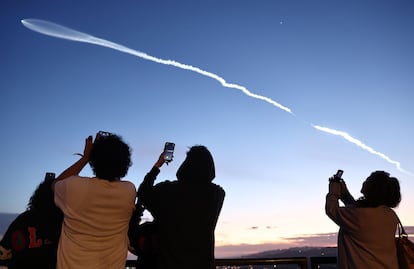An object from the sky smashed through my roof: Space debris is starting to be a problem
The international community is pushing for the approval of rigorous standards that track and limit the obsolete objects that can pass through the atmosphere and cause material damage on Earth

At dawn on Good Friday, a luminous trail crossed the sky of the Spanish Mediterranean coast until it disappeared behind the marine horizon. After the initial stupor, the military commanders in charge of supervising the area reported that it was a “grazing meteoroid” and not a ballistic missile or a Starlink satellite, as was initially thought. The scare brought to the fore the importance of controlling the space debris orbiting Earth.
According to the latest data from the European Space Agency (ESA), some 11,500 tons of objects launched into space are moving at high speed above our heads. The trail pollution is made up of one million pieces of waste, measuring between one and 10 centimeters, and 36,500 larger objects. But that’s only the space debris that’s registered, because not all space trash is cataloged and tracked by the databases that were created after the start of the space race (the ESA monitors about 35,150).
Space debris can be as large as a car or as small as a paint chip. “The real danger is the speed at which they move, more than 28,000 kilometers per hour [17,400 miles per hour], which turns them into real projectiles,” says Efrén Díaz, head of technology and space law at the Mas y Calvet Law Firm and general secretary of the Spanish Association of Aeronautical and Space Law (AEDAE). At this speed, the impact of a sphere measuring just over a centimeter could cause the same damage as a car traveling at 50 km/h.
Today, the greatest threat is from satellites and stations located in Low Earth orbit (LEO), with an altitude of 1,200 miles or less. It’s a place that’s become increasingly crowded as the internet has been brought to all corners of the globe, among other services. More than 2,000 satellites were launched in 2023 alone, most of them from Elon Musk’s Starlink company. With more devices in orbit, space highways become more dangerous. So much so, says Víctor Barrio, senior associate at Hogan Lovells and vice president of AEDAE, “that both satellites and the International Space Station [ISS] frequently maneuver to avoid collisions, thanks to the alerts received from the SST [Space Surveillance and Tracking] services.”
The experts who spoke to EL PAÍS are not alarmist, but they warn that falling space debris is continually bombarding the planet. “Although our atmosphere manages to eliminate most of it, there are objects that manage to pass through it and impact the surface,” explains Barrio. For example, NASA is investigating a complaint made by a Florida citizen, who claimed that the remains of batteries from the ISS crashed into the roof of his house on March 8.
The 1972 Convention on International Liability for Damage Caused by Space Objects establishes that the state that launches the object or “the state that has essentially participated in its manufacture,” is liable, says Barrio. This rule is stricter, explains the lawyer, when the damage occurs on Earth because no fault is not required. In cases like the one in Florida, he explains, the citizen cannot file a case on their own. Rather, it is the states that make claims through diplomatic channels. “The procedure is clear,” he says.
In practice, adds Efrén Díaz, it can be a complex task. Multiple factors can hinder a claim over falling space debris. The main issue, he says, is finding evidence: an investigation cannot be carried out in space. “There are few witnesses,” jokes the expert. What’s more, deciding who is to blame is difficult, “especially if the object is not registered.” Once these issues are resolved, there is then the question of jurisdiction and what laws are applicable, for example, if it was an international launch. Finally, there is no hope of receiving damages “if the person responsible is not willing to offer compensation,” says Díaz.
Air traffic chaos
Another paradigmatic incident took place in 2022, when Spain was forced to close its airspace due to the uncontrolled reentry of remains of a Chinese rocket booster. This situation caused flight delays that, according to European legislation, airlines do not have to cover because as it was an extraordinary event. Although it is debatable whether Spain can demand compensation via the 1972 convention, as there was no physical damage, Barrio is in favor of a broader interpretation of the text to include these extraordinary and “increasingly common” situations.
Regulatory efforts are currently focused on achieving a safer and more sustainable space environment. Juan Carlos Cortés, director of programs and industry at the Spanish Space Agency (AEE), says that “it is possible to require companies and government entities to contribute to reducing space debris.” Barrio also gives an example of the agency’s “Zero Debris” plan for 2030. The ESA, he advances, “is designing specific guidelines to establish safety, responsibility and coordination standards in the launch and maintenance of satellites by private entities.”
There are companies that develop technologies to manage the useful life of satellites and eliminate space debris. Some recommend that obsolete satellites be removed within a maximum five years. These efforts will allow space exploration to continue and allow future generations to contemplate a clear sky of stars.
A trash fee
The idea of charging a trash fee to the countries or companies responsible for space debris to finance the cleanup of the space has been raised on several occasions, according to Efrén Díaz. The lawyer believes that it is difficult for such a system to be implemented in the short term, because it would require an international agreement, and the world is divided geopolitically into polarized sides. “It is an attractive idea that faces significant challenges such as identifying those responsible given that space activities are carried out by a variety of actors,” says Dáaz.
Sign up for our weekly newsletter to get more English-language news coverage from EL PAÍS USA Edition
Tu suscripción se está usando en otro dispositivo
¿Quieres añadir otro usuario a tu suscripción?
Si continúas leyendo en este dispositivo, no se podrá leer en el otro.
FlechaTu suscripción se está usando en otro dispositivo y solo puedes acceder a EL PAÍS desde un dispositivo a la vez.
Si quieres compartir tu cuenta, cambia tu suscripción a la modalidad Premium, así podrás añadir otro usuario. Cada uno accederá con su propia cuenta de email, lo que os permitirá personalizar vuestra experiencia en EL PAÍS.
¿Tienes una suscripción de empresa? Accede aquí para contratar más cuentas.
En el caso de no saber quién está usando tu cuenta, te recomendamos cambiar tu contraseña aquí.
Si decides continuar compartiendo tu cuenta, este mensaje se mostrará en tu dispositivo y en el de la otra persona que está usando tu cuenta de forma indefinida, afectando a tu experiencia de lectura. Puedes consultar aquí los términos y condiciones de la suscripción digital.
More information

An artificial meniscus and 371 days of swallowing toothpaste: Frank Rubio’s adventures in space

Speedy downloads: Why NASA is turning to lasers for next-generation space communications
Archived In
Últimas noticias
‘Fallout’ or how the world’s largest company turned an anti-capitalist apocalyptic Western into a phenomenon
From inflation to defending migrants: Eileen Higgins and Zohran Mamdani inaugurate the new Democratic resistance against Trump
EU’s prestige at stake with proposal to fund Ukrainian war effort with Russian assets
Mustafa Suleyman: ‘Controlling AI is the challenge of our time’
Most viewed
- ‘El Limones’ and the growing union disguise of Mexican organized crime
- Christian Louboutin: ‘Young people don’t want to be like their parents. And if their parents wear sneakers, they’re going to look for something else’
- ‘We are dying’: Cuba sinks into a health crisis amid medicine shortages and misdiagnosis
- The low-cost creative revolution: How technology is making art accessible to everyone
- A mountaineer, accused of manslaughter for the death of his partner during a climb: He silenced his phone and refused a helicopter rescue








































